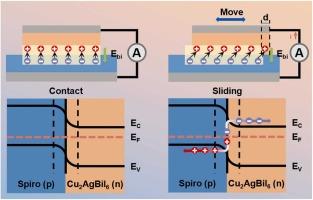Dynamic p-n junction direct current-generating triboelectric nanogenerators based on lead-free perovskite
IF 16.8
1区 材料科学
Q1 CHEMISTRY, PHYSICAL
引用次数: 0
Abstract
Direct current output triboelectric nanogenerator (DC-TENG) based on dynamic p-n junction has important applications in energy harvesting, micro/nano-sensing, etc. In this study, a DC-TENG based on n-type lead-free Cu2AgBiI6 (CABI) perovskite is proposed for the first time, and the output performance of the DC-TENG is enhanced by passivation of CABI films with phenylethylammonium iodide (PEAI) and combining 2,3,5,6-Tetrafluoro-7,7,8,8-tetracyanoquinodimethane (F4TCNQ) and Poly[bis(4-phenyl)(2,4,6-trimethylphenyl)amine] (PTAA) molecular additives into the p-type 2,2ˊ,7,7ˊ-tetrakis (N, N-di-p-methoxyphenyl-amine) 9, 9ˊ-spirobifluorene (Spiro) film. The passivated CABI with PEAI and Spiro+PTAA+F4TCNQ based DC-TENG exhibits a champion voltage of 0.81 V, a current density of 11.23 μA cm−2, and a power density of 1.25 W m−2. Moreover, its feasibility in temperature and humidity sensing and direct powering of capacitors has been demonstrated. This study not only expands the application of lead-free perovskite in DC-TENG, but also proposes an effective strategy to enhance the output performance of DC-TENG and accelerate its development.

求助全文
约1分钟内获得全文
求助全文
来源期刊

Nano Energy
CHEMISTRY, PHYSICAL-NANOSCIENCE & NANOTECHNOLOGY
CiteScore
30.30
自引率
7.40%
发文量
1207
审稿时长
23 days
期刊介绍:
Nano Energy is a multidisciplinary, rapid-publication forum of original peer-reviewed contributions on the science and engineering of nanomaterials and nanodevices used in all forms of energy harvesting, conversion, storage, utilization and policy. Through its mixture of articles, reviews, communications, research news, and information on key developments, Nano Energy provides a comprehensive coverage of this exciting and dynamic field which joins nanoscience and nanotechnology with energy science. The journal is relevant to all those who are interested in nanomaterials solutions to the energy problem.
Nano Energy publishes original experimental and theoretical research on all aspects of energy-related research which utilizes nanomaterials and nanotechnology. Manuscripts of four types are considered: review articles which inform readers of the latest research and advances in energy science; rapid communications which feature exciting research breakthroughs in the field; full-length articles which report comprehensive research developments; and news and opinions which comment on topical issues or express views on the developments in related fields.
 求助内容:
求助内容: 应助结果提醒方式:
应助结果提醒方式:


